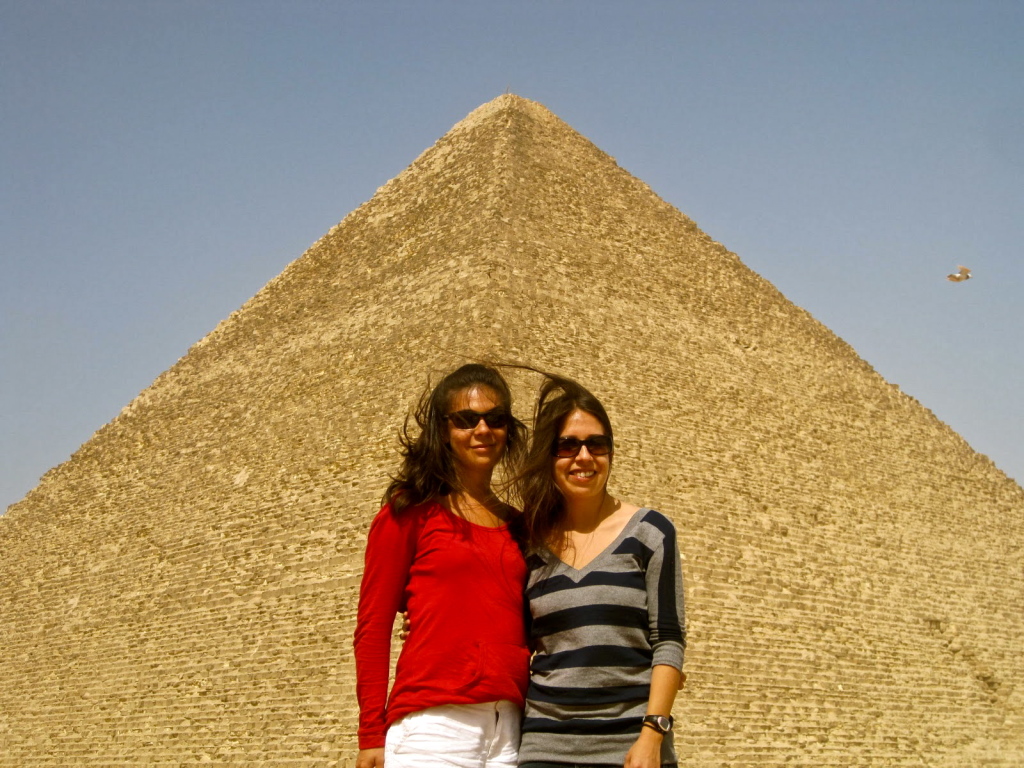
My last stop in the middle east was Cairo. I stayed here for five days. My first stop was Saqqara, a large, ancient burial grounds that features The Pyramid of Djoser (aka. The Step Pyramid).
After leaving Saqqara, I headed to The Great Pyramid of Giza (aka. The Pyramid of Cheops). The Great Pyramid of Giza is one of three pyramids in The Giza Necropolis. It is the oldest, largest, most intact, and best-known pyramid in Egypt. In fact, it is considered one of the Seven Wonders of the Ancient World.
After seeing my first “Wonder” I was so impressed that I wanted to know what the other six are. They include:
- Hanging Gardens of Babylon (Iraq)
- Temple of Artemis at Ephesus (Turkey)
- Statue of Zeus at Olympia (Greece)
- Mausoleum of Halicarnassus (Turkey)
- Colossus of Rhodes (Greece)
- Lighthouse of Alexandria (Egypt)
The Great Pyramid of Giza.
The Great Sphinx.
Six steps on The Step Pyramid.
Renovation on The Step Pyramid is ongoing.
Roofed collonade corridor leading into the Saqqara complex.
A dog frolicking in the Saqqara complex.
The Great Pyramid of Giza.
The Great Pyramid of Giza is an engineering marvel. The picture below, taken at a sideways angle, demonstrates how straight the edges of this pyramid are:
For a couple of Egyptian pounds (1 USD is about 6 Egyptian pounds) we were able to take a short camel ride at The Giza Necropolis.
My sister and her camel, Mickey Mouse.
Two of the three pyramids of the Giza Necropolis.
The Giza Necropolis also features The Great Sphinx. A sphinx is a mythical creature with a human head and a lion’s body. There are many sphinx throughout Egypt. However, The Great Sphinx is the largest. One of the most remarkable things about this statue is that it was carved out of a single piece of stone.
Slightly better view of the sphinx’s lion body. One of the three Giza pyramids is visible in the background.
While Egypt is predominately an Islamic state, there is also some Christian influence. We visited Saint Virgin Mary’s Coptic Orthodox Church (aka. The Hanging Church).
Outside The Hanging Church.
The Bible indicates that Mary, Joseph and Jesus fled to Egypt when Jesus was a young boy in order to escape Herod’s massacre of children in Bethlehem. The Hanging Church is built over one of the places where they lived.
I also visited a famous mosque in Cairo called The Mosque of Muhammad Ali Pasha (aka. The Alabaster Mosque). Muhammad Ali is considered the founder of modern Egypt because of the many reforms he instituted.
Exterior of the mosque.
Interior of the mosque.
I should also mention the Egyptian Museum. It houses 120,000 antiquities, including mummies. No pictures are allowed inside. It’s well-worth the time.
A pond with lotus and papyrus in front of the Egyptian Museum.
In addition to the obvious tourist sites, Cairo also has great food and souvenirs.
The papyrus plant. One Egyptian souvenir is artwork drawn on papyrus paper. Incredibly durable, papyrus artwork is guaranteed to last 1,000 years. Be sure to buy at a reputable location; many vendors try to sell tourists fake papyrus.
Some treats at an Egyptian bakery.
Abou Tarek, a famous restaurant in Cairo.
The signature dish at Abou Tarek’s. It’s called koshary and it rocks.
Smoking apple-flavored hookah at a cafe in downtown Cairo.
The Nile River.
A shopping mall in Cairo. It’s the largest mall in Africa. I saw “The Rite” with Anthony Hopkins, a horror movie about exorcisms. Afterwards, I had cappuccino at a Cinnabon in the mall. Random.
After two months, travel has changed me in so many ways. Before this trip, I was oblivious to many world events. It’s not that I couldn’t understand; I just didn’t try to understand. It was enough for me to acknowledge them superficially and not try to pry below the surface, into the intricacies.
I put almost no effort into trying to figure out where these countries with “strange” names were located (Tunisia, for example), what their people and culture are like, and how their governments work. I suppose I had tunnel-vision; all I really saw was what was happening in the United States.
Tahrir Square:location of the Egyptian Revolution in February 2011.
A peaceful demonstration taking place in Tahrir Square.
Getting the Egyptian flag painted on my hand by a demonstrator.
After a few weeks overseas, I find my world perspective shifting. Suddenly, I want to know where every country in the world is located. I’ve got a world map and I study it nearly every day, trying to memorize all of the countries. Madagascar is here. Sri Lanka is there. Armenia is over there. Oh, that’s where Oman is located!
It’s liberating to put “names to faces.” To really try to put a name to a face. This is one way travel has changed me.
Leave a Reply



























